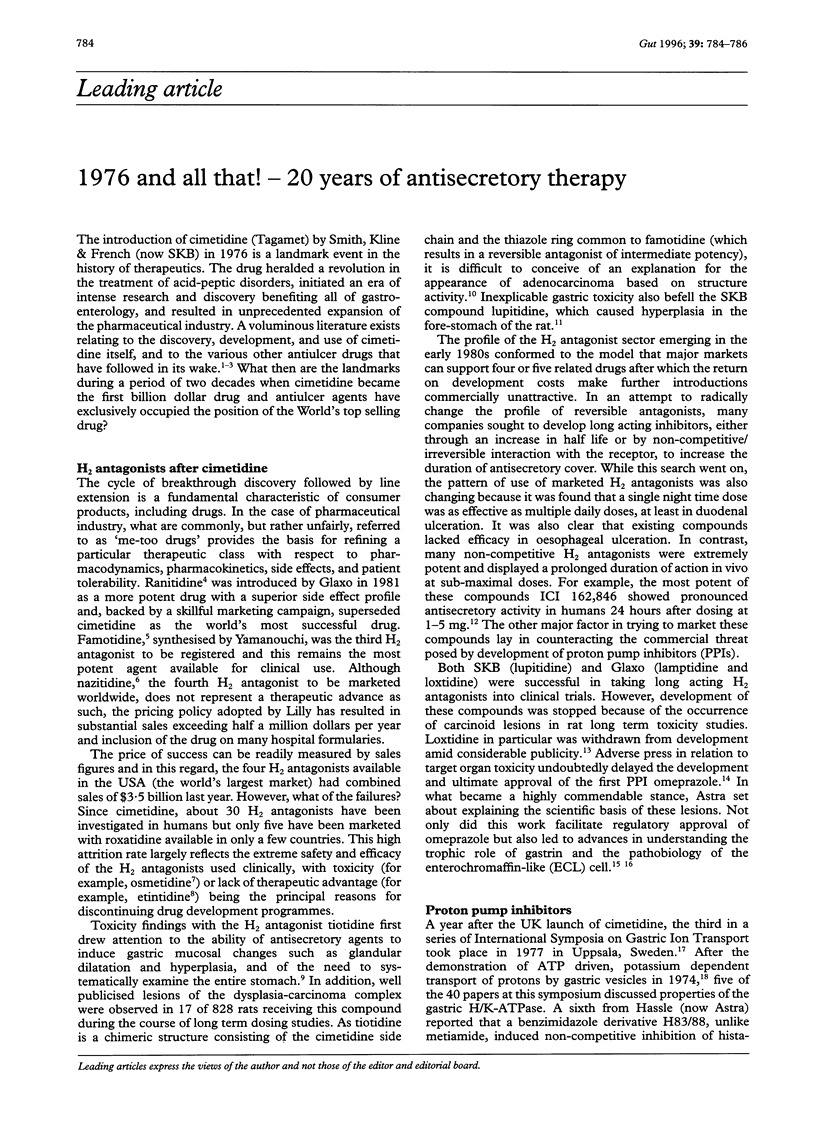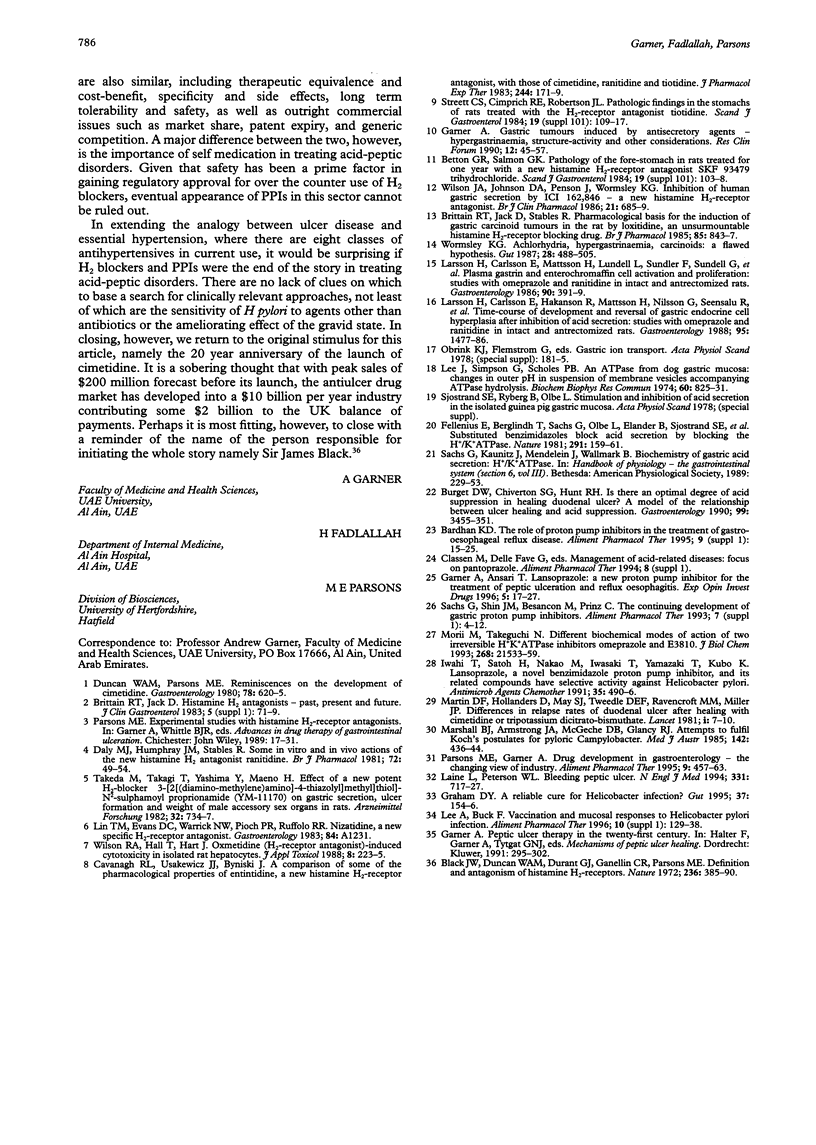Full text
PDF


Selected References
These references are in PubMed. This may not be the complete list of references from this article.
- Bardhan K. D. The role of proton pump inhibitors in the treatment of gastro-oesophageal reflux disease. Aliment Pharmacol Ther. 1995;9 (Suppl 1):15–25. doi: 10.1111/j.1365-2036.1995.tb00779.x. [DOI] [PubMed] [Google Scholar]
- Betton G. R., Salmon G. K. Pathology of the forestomach in rats treated for 1 year with a new histamine H2-receptor antagonist, SK&F 93479 trihydrochloride. Scand J Gastroenterol Suppl. 1984;101:103–108. [PubMed] [Google Scholar]
- Black J. W., Duncan W. A., Durant C. J., Ganellin C. R., Parsons E. M. Definition and antagonism of histamine H 2 -receptors. Nature. 1972 Apr 21;236(5347):385–390. doi: 10.1038/236385a0. [DOI] [PubMed] [Google Scholar]
- Brittain R. T., Jack D. Histamine H2-antagonists--past, present and future. J Clin Gastroenterol. 1983;5 (Suppl 1):71–79. doi: 10.1097/00004836-198312001-00007. [DOI] [PubMed] [Google Scholar]
- Brittain R. T., Jack D., Reeves J. J., Stables R. Pharmacological basis for the induction of gastric carcinoid tumours in the rat by loxtidine, an insurmountable histamine H2-receptor blocking drug. Br J Pharmacol. 1985 Aug;85(4):843–847. doi: 10.1111/j.1476-5381.1985.tb11083.x. [DOI] [PMC free article] [PubMed] [Google Scholar]
- Burget D. W., Chiverton S. G., Hunt R. H. Is there an optimal degree of acid suppression for healing of duodenal ulcers? A model of the relationship between ulcer healing and acid suppression. Gastroenterology. 1990 Aug;99(2):345–351. doi: 10.1016/0016-5085(90)91015-x. [DOI] [PubMed] [Google Scholar]
- Cavanagh R. L., Usakewicz J. J., Buyniski J. P. A comparison of some of the pharmacological properties of etintidine, a new histamine H2-receptor antagonist, with those of cimetidine, ranitidine and tiotidine. J Pharmacol Exp Ther. 1983 Jan;224(1):171–179. [PubMed] [Google Scholar]
- Daly M. J., Humphray J. M., Stables R. Some in vitro and in vivo actions of the new histamine H2-receptor antagonist, ranitidine. Br J Pharmacol. 1981 Jan;72(1):49–54. doi: 10.1111/j.1476-5381.1981.tb09103.x. [DOI] [PMC free article] [PubMed] [Google Scholar]
- Duncan W. A., Parsons M. E. Reminiscences of the development of cimetidine. Gastroenterology. 1980 Mar;78(3):620–625. [PubMed] [Google Scholar]
- Graham D. Y. A reliable cure for Helicobacter pylori infection? Gut. 1995 Jul;37(1):154–156. doi: 10.1136/gut.37.1.154. [DOI] [PMC free article] [PubMed] [Google Scholar]
- Iwahi T., Satoh H., Nakao M., Iwasaki T., Yamazaki T., Kubo K., Tamura T., Imada A. Lansoprazole, a novel benzimidazole proton pump inhibitor, and its related compounds have selective activity against Helicobacter pylori. Antimicrob Agents Chemother. 1991 Mar;35(3):490–496. doi: 10.1128/aac.35.3.490. [DOI] [PMC free article] [PubMed] [Google Scholar]
- Laine L., Peterson W. L. Bleeding peptic ulcer. N Engl J Med. 1994 Sep 15;331(11):717–727. doi: 10.1056/NEJM199409153311107. [DOI] [PubMed] [Google Scholar]
- Larsson H., Carlsson E., Håkanson R., Mattsson H., Nilsson G., Seensalu R., Wallmark B., Sundler F. Time-course of development and reversal of gastric endocrine cell hyperplasia after inhibition of acid secretion. Studies with omeprazole and ranitidine in intact and antrectomized rats. Gastroenterology. 1988 Dec;95(6):1477–1486. doi: 10.1016/s0016-5085(88)80066-0. [DOI] [PubMed] [Google Scholar]
- Larsson H., Carlsson E., Mattsson H., Lundell L., Sundler F., Sundell G., Wallmark B., Watanabe T., Håkanson R. Plasma gastrin and gastric enterochromaffinlike cell activation and proliferation. Studies with omeprazole and ranitidine in intact and antrectomized rats. Gastroenterology. 1986 Feb;90(2):391–399. doi: 10.1016/0016-5085(86)90938-8. [DOI] [PubMed] [Google Scholar]
- Lee A., Buck F. Vaccination and mucosal responses to Helicobacter pylori infection. Aliment Pharmacol Ther. 1996 Apr;10 (Suppl 1):129–138. doi: 10.1046/j.1365-2036.1996.22164013.x. [DOI] [PubMed] [Google Scholar]
- Lee J., Simpson G., Scholes P. An ATPase from dog gastric mucosa: changes of outer pH in suspensions of membrane vesicles accompanying ATP hydrolysis. Biochem Biophys Res Commun. 1974 Sep 23;60(2):825–832. doi: 10.1016/0006-291x(74)90315-5. [DOI] [PubMed] [Google Scholar]
- Marshall B. J., Armstrong J. A., McGechie D. B., Glancy R. J. Attempt to fulfil Koch's postulates for pyloric Campylobacter. Med J Aust. 1985 Apr 15;142(8):436–439. doi: 10.5694/j.1326-5377.1985.tb113443.x. [DOI] [PubMed] [Google Scholar]
- Martin D. F., Hollanders D., May S. J., Ravenscroft M. M., Tweedle D. E., Miller J. P. Difference in relapse rates of duodenal ulcer after healing with cimetidine or tripotassium dicitrato bismuthate. Lancet. 1981 Jan 3;1(8210):7–10. doi: 10.1016/s0140-6736(81)90114-8. [DOI] [PubMed] [Google Scholar]
- Masuoka J., Hegenauer J., Van Dyke B. R., Saltman P. Intrinsic stoichiometric equilibrium constants for the binding of zinc(II) and copper(II) to the high affinity site of serum albumin. J Biol Chem. 1993 Oct 15;268(29):21533–21537. [PubMed] [Google Scholar]
- Parsons M. E., Garner A. Review article: drug development in gastroenterology--the changing view of industry. Aliment Pharmacol Ther. 1995 Oct;9(5):457–463. doi: 10.1111/j.1365-2036.1995.tb00407.x. [DOI] [PubMed] [Google Scholar]
- Penston J., Wormsley K. G. Achlorhydria: hypergastrinaemia: carcinoids--a flawed hypothesis? Gut. 1987 Apr;28(4):488–505. doi: 10.1136/gut.28.4.488. [DOI] [PMC free article] [PubMed] [Google Scholar]
- Sachs G., Shin J. M., Besancon M., Prinz C. The continuing development of gastric acid pump inhibitors. Aliment Pharmacol Ther. 1993;7 (Suppl 1):4-12, discussion 29-31. doi: 10.1111/j.1365-2036.1993.tb00582.x. [DOI] [PubMed] [Google Scholar]
- Streett C. S., Cimprich R. E., Robertson J. L. Pathologic findings in the stomachs of rats treated with the H2-receptor antagonist tiotidine. Scand J Gastroenterol Suppl. 1984;101:109–117. [PubMed] [Google Scholar]
- Takeda M., Takagi T., Yashima Y., Maeno H. Effect of a new potent H2-blocker, 3-[[[2-(diaminomethylene)amino]-4-thiazolyl]methyl]thio]-N2-sulfamoyl propionamidine (YM-11170), on gastric secretion, ulcer formation and weight of male accessory sex organs in rats. Arzneimittelforschung. 1982;32(7):734–737. [PubMed] [Google Scholar]
- Willson R. A., Hall T., Hart J. Oxmetidine (H2 receptor antagonist) induced cytotoxicity in isolated rat hepatocytes. J Appl Toxicol. 1988 Jun;8(3):223–225. doi: 10.1002/jat.2550080311. [DOI] [PubMed] [Google Scholar]
- Wilson J. A., Johnston D. A., Penston J., Wormsley K. G. Inhibition of human gastric secretion by ICI 162,846--a new histamine H2-receptor antagonist. Br J Clin Pharmacol. 1986 Jun;21(6):685–689. doi: 10.1111/j.1365-2125.1986.tb05234.x. [DOI] [PMC free article] [PubMed] [Google Scholar]


